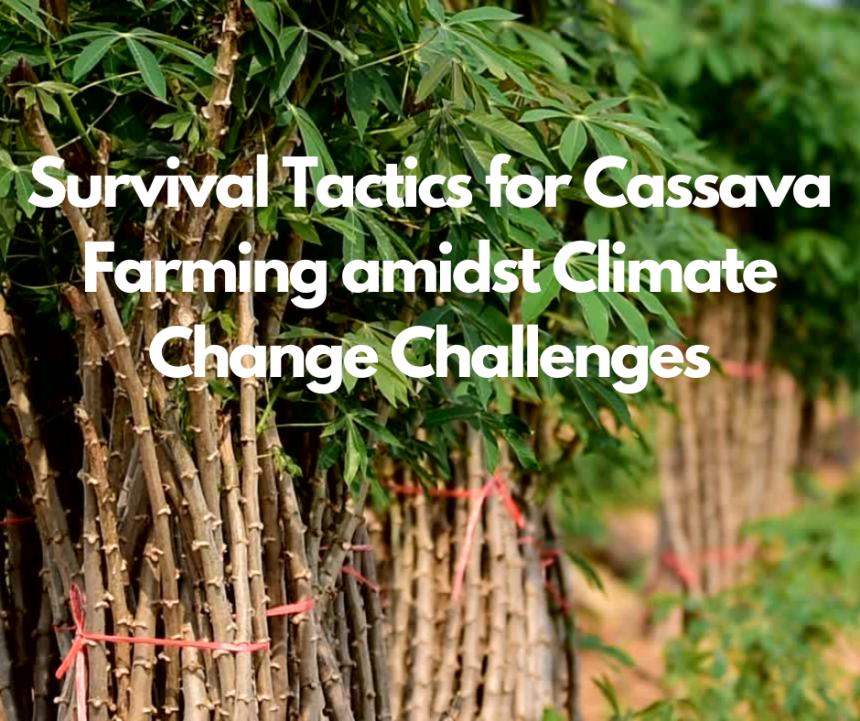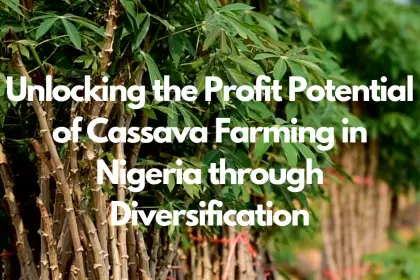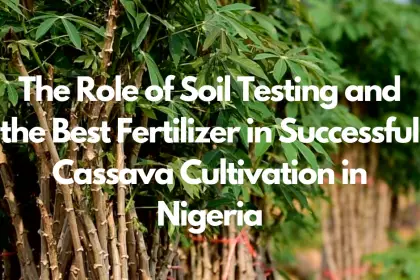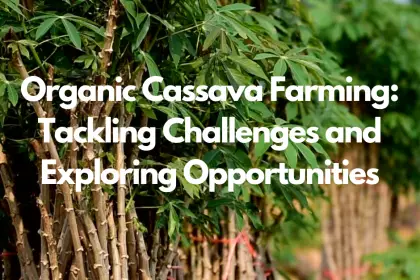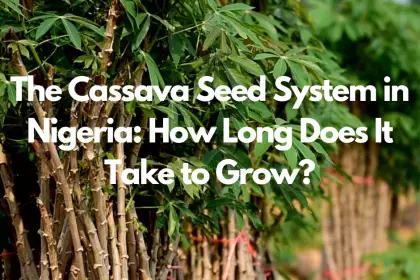Cassava farming, a cornerstone of agriculture in Nigeria, is facing unprecedented challenges due to climate change. These changes threaten the cassava harvest, impacting food security and livelihoods. As the effects of climate change advance, understanding its impact on cassava production becomes crucial for farmers aiming to sustain and improve their yields amidst these adversities.
This article delves into strategies for adapting cassava farming to climate change, including the embrace of technological innovations and the support of community and governmental efforts. Highlighting successful case studies, it offers a roadmap for resilient cassava plantations in Nigeria, ensuring the sustainability of this vital crop in the face of changing global climate patterns.
Understanding Climate Change Impact on Cassava Production
Climate change significantly affects cassava farming in Nigeria, impacting various factors crucial for the crop’s growth and yield. Here’s a closer look at how these changes influence cassava production:
- Arable Land and Rainfall: The availability and quality of arable land, along with changes in rainfall patterns, play a significant role in cassava yield. Increased rainfall variability and temperature fluctuations have been linked to a decrease in income and daily calorie intake among farmers, underscoring the importance of understanding and adapting to these changes.
- Greenhouse Gases Impact: Greenhouse gases, including C2O, nitrous oxide, and methane, have a long-term significant impact on cassava yield. Methane, in particular, causes the most damage, highlighting the need for strategies to mitigate these effects.
- Dual Impact of Climate Variables: Temperature, rainfall, humidity, number of rainy days, and sunshine hours are key climate variables that affect cassava production. These variables have dual impacts, influencing cassava yield both positively and negatively. For example, cassava thrives in warm temperatures between 77°F and 86°F but can be damaged by extreme temperatures, especially frost. Similarly, adequate and well-distributed rainfall supports optimum growth, yet changes in rainfall patterns, such as prolonged droughts or excessive rainfall, can negatively impact production.
Understanding these impacts is crucial for developing effective adaptation strategies to secure cassava yield and food security in Nigeria amidst climate change challenges.
Key Climate Change Adaptation Strategies
In adapting to climate change, cassava farmers across various regions have developed a range of strategies, reflecting the diversity and innovation within the agricultural community. These strategies are crucial for maintaining cassava production, a staple food and significant income source in many communities.
- Varietal Improvement and Crop Management:
-
- Planting improved cassava varieties (95.9%)
- Use of pest and disease-resistant varieties
- Adjusting planting and harvesting dates (95.7%)
- Appropriate application of fertilizer (97.1%) and efficient use of pesticide (97.4%)
- Adaptive Practices and Resource Management:
-
- Diversification of crops planted (96.9%) and livelihood diversification (94.9%)
- Soil and water conservation techniques (93.3%) and irrigation (90.2%)
- Erosion control measures (96.4%) and increased land access (47.9%)
- Information and Collaboration:
-
- Reliance on climate information and forecasts (94.0%)
- Collaboration with extension workers/agents (95.2%)
- Seeking early warning signals and information on climate change
These strategies, informed by factors such as age, education, household size, farm size, and extension contacts, underscore the importance of a multi-faceted approach to adapting cassava farming practices in the face of climate change.
Technological Innovations in Cassava Farming
In the realm of cassava farming, technological innovations have significantly advanced, offering new avenues for enhancing production and quality. These innovations span from genomic resources to practical field technologies:
- Genomic Advances:
-
- The development of a cassava chromosome-scale reference genome and the re-sequencing of diverse accessions have provided a foundation for understanding genetic variations.
- High-throughput genotyping platforms and low-cost genotyping technologies facilitate rapid and accurate fingerprinting, crucial for breeding programs.
- Genetic diversity studies have highlighted differences between African and South American germplasm, informing breeding strategies.
- Field Evaluation Tools:
-
- Portable devices like ICheckTM carotene and color instruments offer rapid assessment of carotenoids content directly in the field.
- Near-infrared spectroscopy (NIRS) is utilized not only for carotenoids quantification but also for estimating cyanide potential and various starch properties, enhancing the selection process for quality traits.
- Innovative Solutions for Challenges:
-
- CassVita’s transformation technology dramatically extends cassava’s shelf-life from 2 days to 18 months, addressing post-harvest losses.
- An informational and coordinating technology funded by FID includes an alert system and a notification tool, improving cassava cultivation synchronization and farmer coordination.
These technological strides not only improve cassava yield and quality but also offer solutions to longstanding challenges like genetic resource management and post-harvest losses, marking a significant leap forward in cassava farming practices.
Community and Governmental Support in Adaptation Efforts
In Abia State, Nigeria, cassava farmers encounter several barriers to adapting to climate change, including:
- Limited Resources: Access to farmland and farm inputs is scarce, alongside a notable lack of credit facilities.
- Knowledge Gap: There’s a widespread lack of awareness about coping mechanisms and resilience strategies against climate change impacts.
- Infrastructure and Support: The non-availability of weather forecasts, government’s slow response to climate change effects, and the high cost and limited access to labor further exacerbate the challenges.
To combat these issues, the following measures are recommended:
- Enhanced Training and Awareness: Conduct regular training sessions on climate change and its variability. This includes making meteorological data readily accessible to farmers.
- Improved Cassava Varieties: Ensure the steady availability of improved cassava varieties that are more resilient to climate change.
- Policy and Land Use Review: A revision of the Land Use Act of 1990 could facilitate increased access to land for farming activities.
In Kenya, government and community efforts have shown significant positive impacts on cassava farming through:
- Research and Development: Investment in research for developing pest- and disease-resistant cassava varieties.
- Capacity Building: Implementing training programs and workshops on modern farming techniques and value addition.
- Financial and Infrastructure Support: Providing financial support mechanisms and improving rural infrastructure to reduce post-harvest losses.
- Market Access and Policy Support: Enhancing market access, implementing supportive policies, and promoting climate-smart agriculture practices.
These initiatives highlight the importance of a collaborative approach between the community, government, and other stakeholders in adapting cassava farming to climate change challenges.
Case Studies
Exploring the resilience and adaptability of cassava farming across different regions, several case studies shed light on innovative practices and challenges:
- Chilonga Ward, Chiredzi District, Zimbabwe:
-
- Cassava’s extensive root system makes it a viable climate change adaptation strategy.
- Emphasis on value-added products enhances economic benefits.
- South Africa:
-
- Initiatives aim to scale up cassava for industrial starch production.
- Recognized as a food security crop, offering industrial opportunities for small-scale farmers.
- Phu Cat District, Binh Dinh Province, Nigeria:
-
- A community-based model tested intensive and intercropping cultivation (cassava and peanut).
- Challenges remain in fully exploiting advantages such as using manure from livestock and agricultural residues to improve soil and reduce costs.
Key Takeaways:
- Cassava farmers are predominantly male, educated, and experienced.
- Climate variables such as temperature, rainfall, and sunshine hours significantly influence cassava production.
These insights underscore the importance of tailored strategies to leverage cassava farming’s full potential amidst climate challenges, highlighting the crop’s adaptability and the critical role of innovative practices.
Conclusion
As we have seen, cassava farming in areas like Nigeria is at a crossroads due to the pressing challenges posed by climate change. Through exploring the impact of these environmental shifts on cassava yield, the adaptation strategies employed by farmers, the role of technological innovations, and the vital support from communities and governments, this article has charted a course towards ensuring the sustainability and resilience of cassava production. The strategies and innovations discussed underscore the necessity of a proactive approach, blending traditional wisdom with modern science to preserve cassava as a cornerstone of food security and livelihoods in the face of a changing climate.
The significance of these efforts extends beyond cassava farming, offering lessons and inspiration for agriculture sectors worldwide grappling with similar issues. By highlighting the successful case studies and the importance of collaborative support, the article emphasizes that while challenges are significant, they are not insurmountable. Encouraging further research and action in this domain not only promises to enhance cassava yield in the wake of climate adversities but also reinforces the broader imperative of sustainable agricultural practices globally. This journey towards adaptation and resilience is not only crucial for today’s farmers but also for future generations who will inherit these challenges.
FAQs
What are the approaches to manage the effects of climate change on the environment?
To cope with the impacts of climate change, one can engage in eco-friendly actions to alleviate associated stress, adopt a problem-solving mindset, reframe thoughts about climate change in a more constructive manner, seek social support, become more engaged with the issue, and practice expressive coping.
What tactics can be employed for climate-resilient farming?
To achieve climate resilience in agriculture, strategies such as building ponds, check dams, and farm ponds are effective. These structures help in harvesting and storing rainwater, which can recharge groundwater supplies and provide irrigation during periods of drought or for additional watering needs, thus minimizing reliance on unpredictable rainfall.
How is the agricultural sector adapting to the changing climate?
The agricultural sector is adapting to climate change through various strategies and actions that can be implemented at local and regional levels. These include developing and managing crop varieties with innovative breeding techniques, improving water and soil management through agronomic practices, and enhancing farmer education and knowledge dissemination.
What difficulties do cassava farmers encounter?
Cassava farmers face several challenges such as the lengthy time required for the crop to mature, variability and low levels of dry matter and starch, high cyanogenic content which can be toxic, subpar cooking qualities, and diseases like cassava bacterial blight and root rot, particularly in forested regions.

